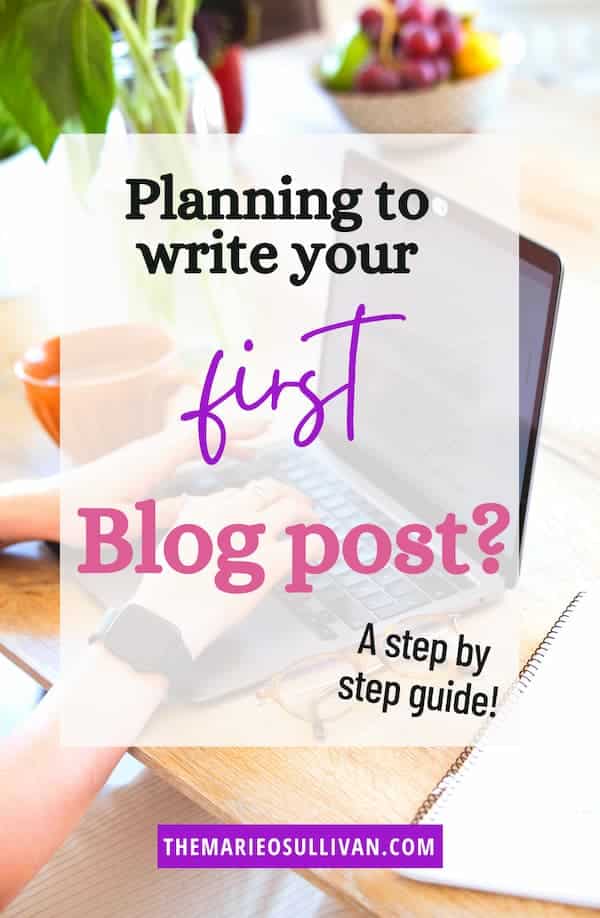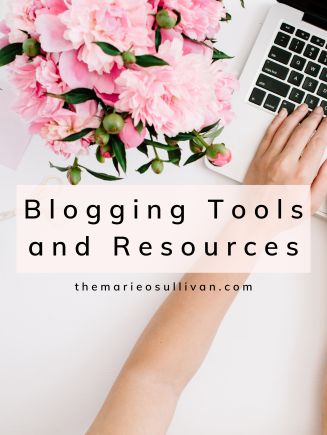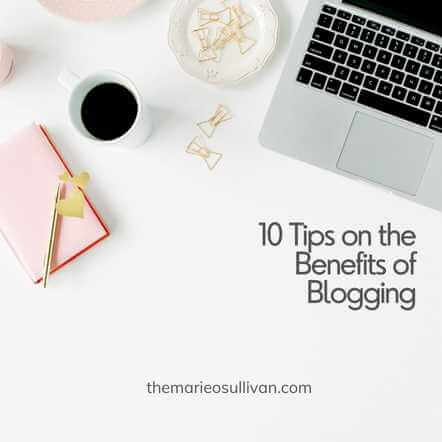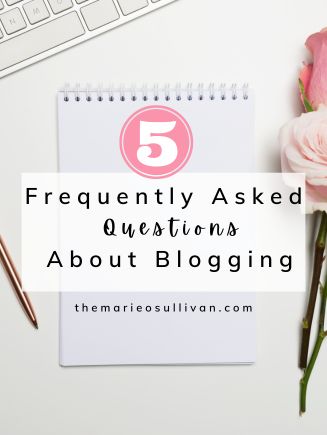Planning to write your first blog post? Exciting (and maybe a bit terrifying!)- you’ll get the most out of this guide if you follow the steps and give each one a go.
Publishing my first blog post took me way too long because I felt really unsure of the steps to follow, so I wanted to share how you can do it much faster, without letting perfectionism, Imposter Syndrome, or overwhelm get in the way. This way, your first blog post shouldn’t feel as daunting.
This blog post contains an affiliate link which means I may receive a commission if you purchase through a link. However, please be assured that I only recommend products I have personally used and love! If you purchase through my link it won’t cost you any extra.
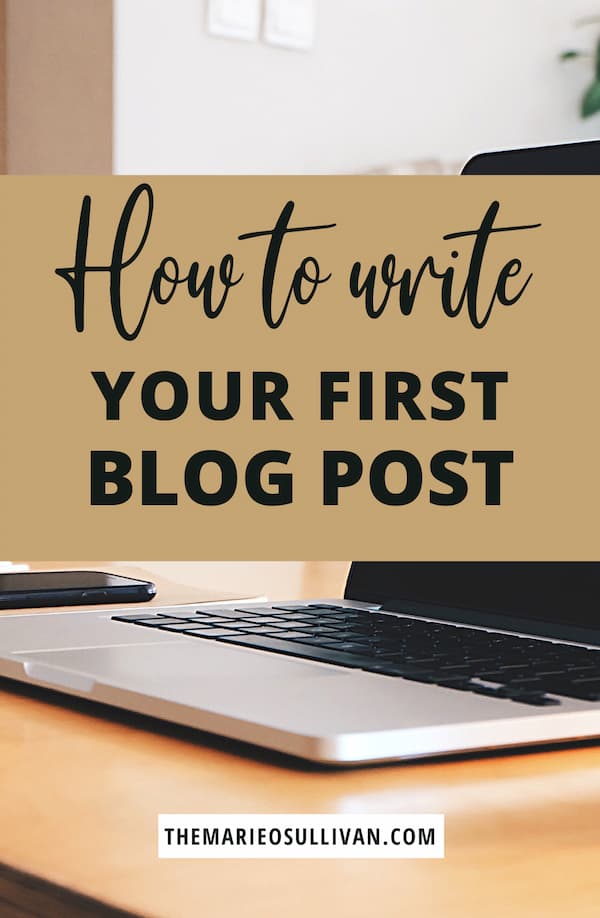
.](https://themarieosullivan.com/wp-content/uploads/2023/04/List-Post-Template-1024x1024-1.jpg)
This guide is designed to cover everything you need to write your first-ever blog post and will take you from knowing next to nothing about what makes a good blog post to hitting publish on your first post.
If you are a little further along in your blog writing journey, you can either reread this blog to refresh your memory or scan it to make sure you’re checking all the steps off.
Since I’ve tried to capture as much information as humanly possible in this beginner’s guide to writing your first ever blog post, there is a lot of info in here.
But never fear, I’ve made it easy for you to find exactly what you’re looking for by clicking on the links below and tech magic will instantly bring you to the right section.
What I'll cover
The Basics of Blogging
Don’t worry, this isn’t a history lesson, just a quick run-through of what you need to know so you can start a blog on the right foot.
What is a blog post?
A blog post is an online article that you publish, either on your own website or on another website.
Years ago, these were mostly in the form of an online diary and over time the term “web log” got condensed to “blog”.
Now, blogging is often used by businesses to share helpful information with website visitors, so if you’ve been concerned that you wouldn’t be taken seriously as a therapist or coach if you blog, let me dispel that myth right now.
I remember writing my first post and feeling simultaneously terrified that nobody would read it and terrified that they would!
Benefits Of Writing A Blog Post
Writing a blog post is a great way to share tips, “how-to” information and helpful resources with your audience. It’s about being seen as the “go-to” person on your topic of expertise (and letting more people know you exist).
Your blogs can help potential clients to become aware of your services and offers and help Google (and other search engines) to understand what your website is about.
Combine the information in this beginner’s guide for coaches and therapists to write your first blog post with practice and you’ll be able to write a great post in no time!
Click here to read more about the benefits of blogging >> 10 Tips on the Benefits Of Blogging
9 Beginner Steps to Writing Your First-Ever Blog Post
Using this guide, you can follow the 10 steps to writing the first post for your website. By following the process writing blog posts will come more easily.
Step 1. Brainstorm blog post ideas
Step 2. Pick a captivating title to hook the reader in
Step 3. Create an outline (& messy first draft)
Step 4. Circle back and write a compelling intro
Step 5. Edit
Step 6. Source images
Step 7. Add a Call to Action
Step 8. Adding Links to Your Post
Step 9: Sharing Your Post
Please don’t worry if these steps don’t (yet) make sense. I’ll be making sure to explain them really clearly so you know exactly what to do by the time you read the last step.
If you’re just starting out, knowing where to begin can be intimidating. Not to mention that writer’s block and a good old dose of Imposter Syndrome can also kick in. sigh
But don’t let this put you off. You absolutely can do this and remember that your posts can help people and help you grow your business.
Brainstorming Ideas for Your First Blog Post
Let’s start you off on the right foot. A weird thing can happen when you sit down to write – all the ideas disappear and all of a sudden you can’t think of any topics for your blog. So let’s make sure that doesn’t happen to you.
Writing your first blog post can seem like a daunting task, but with the right approach, it can be an exciting and rewarding experience.
Start by asking yourself “What topics would my audience want to read about?” Asking this question helps you focus on writing content that will resonate with your readers.
1. What are your people currently stuck on?
Instead of trying to come up with an idea for a blog post, I want you to think of one client you really enjoyed working with. What would be helpful for them to know?
It could be a breathing technique, a book or podcast you’d love to share with them, or a few tips to help them wind their kids down at night.
Do not overthink this. Do not start second-guessing yourself. No, everybody does not know this already (and even if they do, they still need to hear it again)!
You are not trying to write a completely unique, original set of tips. You are just trying to share enough useful information to help that one person along. And down the line, you’ll thank yourself because you can share that blog post over and over again to help multiple clients.
Want to skip to some blog post examples?
2. Research blog topics related to your niche
If thinking about what your clients are stuck on isn’t really doing it for you – research blog topics related to your niche and see what others are talking about. This gives you ideas for potential angles that you can take on a particular topic or issue.
Ask yourself if there are any gaps in the current online conversation or if you have something to add to the mix.
Write down what comes to mind (or make a note on your phone if thinking aloud comes more naturally to you).
Write from the heart – don’t try to push a specific agenda or be too salesy.
3. Have a look at Pinterest Keyword Search
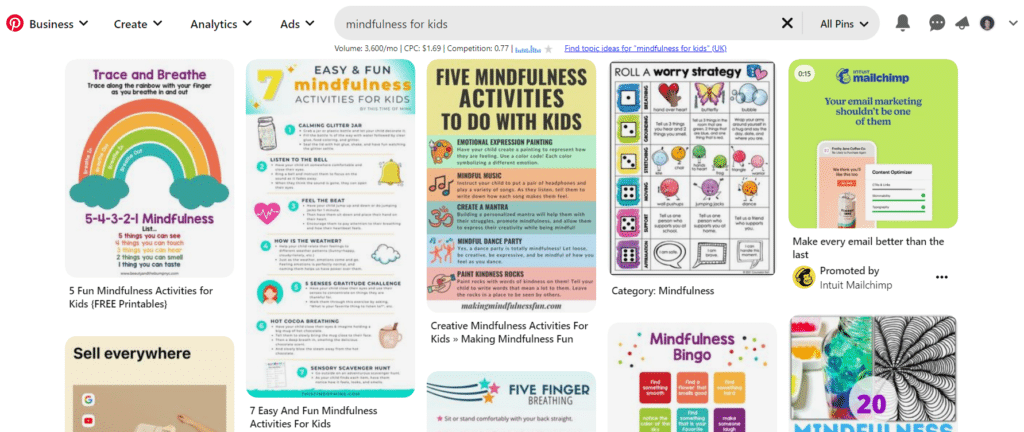
Type in your topic e.g. “mindfulness activities for kids”. Pinterest will display related search terms – these are terms people are actively searching for.
4. Check out Google Trends
Enter your search term into Google Trends. Look up the related trends and related topics. If there isn’t enough data showing up, change your search filter to worldwide. This is about getting you out of a creativity rut and sparking inspiration.

Now it’s time to decide the type of blog post you are going to write.
If you’re stuck try one of these formulas:
- How to
- List-post
- Useful resources
Step 2. Pick a captivating title to hook the reader in
Choosing a blog post title can feel really difficult. Here are some tips to help you.
E.g. Why is {your topic} important for {outcome}?
Questions can be good because as humans we’re naturally curious and want to close the loop!
Click here to explore a helpful tool for generating better headlines >>
To get started, focus on creating an engaging title for your blog post. Make sure it contains keywords related to the topics you want to cover and gives readers a good idea of what they should expect from the article.
Once you have a title picked out, start by outlining all of the points you plan to cover in your blog post. This will help keep you organized and make it easier for you to put together an engaging piece of content that resonates with readers.
Step 3. Outline Your Post (& messy first draft)
Now that you’ve chosen your blog post topic it’s time to bullet point an outline (this will save you huge heartache). Outlining your main points will make sure you cover all the key points you intend to. It’ll also make it way easier for your readers to follow the content of your blog.
You’ll also find it easier to get started once you’ve outlined your whole post.
Now it’s time to get your bottom in the chair, get cracking and give yourself permission not to write the best post ever on the first go. You’ll circle back and edit your post later, but for now, focus and just write the blog!
Reading your first draft can be agonising and your inner critic might be off the Richter scale. This is perfectly normal.
Step 4. Circle back and write a compelling intro
Crafting An Engaging Introduction
Writing and publishing your first-ever blog post can be an exciting yet daunting prospect. After all, it’s the gateway to connecting with potential customers, building credibility, and increasing traffic to your website. However, crafting a captivating introduction is key for readers to keep reading and wanting more.
So let’s look at some tips for writing the perfect blog post introduction. First of all, it should have a hook – something that captures the reader’s attention right away. Secondly, it should explain who you are and why you’re qualified to write about this topic – this builds trust with your reader. Finally, you want to provide an overview of what they can expect from your post so they know what they’ll get out of reading it.
By combining these three elements in your introduction – hooking the reader, establishing yourself as an authority on the topic, and providing an overview of what they can expect – you’ll be well on your way to writing your first blog post successfully!
Step 5. Edit
Writing And Editing Tips
It’s time to write!
If writing an entire blog post in one sitting feels daunting, chunk the task down and just complete one section of your outline.
Using the right tone and language is key. To create an engaging blog post, you need to make sure that the words you use match the feelings and emotions that you want to convey.
Using appropriate tone and language can be tricky for first-time bloggers, but with a few simple guidelines, you can ensure that your blog post will engage readers.
First of all, when you write your blog post, try to think of it as though you are having a conversation with someone – choose words and phrases that evoke emotion from the reader.
Secondly, avoid jargon or technical terms if possible – remember that most of your readers won’t have any prior knowledge of the topic so keep things simple.
Finally, don’t be afraid to inject some personality into your writing; if you’re passionate about the subject matter then let this show through in your words.
By following these tips when writing your first blogs, you can ensure that they are engaging and enjoyable reads for all types of audiences. Make sure that every word counts towards conveying the message or emotion that you want readers to take away from reading your work.
Writing a great blog post takes practice but by keeping these tips in mind you are well on your way to becoming an expert blogger!
The last thing you want to do is publish something that is full of mistakes. This is why proofreading and editing are essential steps of the process. It’s important to ensure that your post is error-free before it goes live – no matter how much time you put into creating the content itself.
Proofreading
To make sure your post is ready for publishing, take the time to review it thoroughly. I suggest reading your post twice: once for content and once for grammar/spelling mistakes.
Pay attention to sentence structure, punctuation, and any other potential typos that could be present in your copy. If you’re not confident in your editing skills, consider having someone else look over your work before you hit ‘publish’.
Once you’ve gone through everything and corrected any errors, check one more time before your post is published – just to be sure! When all of this is done, you can confidently hit ‘publish’ on your blog post knowing it was written with quality in mind and will help keep readers engaged with its content.
Focus on making your content easy to digest. Think about providing readers with clear signposts throughout the article that guide them along the journey.
Use headings, bullet points and short paragraphs to break up the text and make it easier for readers to engage with your content quickly and effortlessly on their phones – which will ultimately lead to better engagement and conversions!
Break up longer paragraphs and sentences into shorter ones with clear transitions between them.
Re-read your post with fresh eyes for accuracy and clarity, or even better ask someone else to read it to catch the things you missed!
Check for typos and other errors with Grammarly.
Pro tip: Reading what you’ve written aloud can help make your post better because you’ll spot any clunky phrases
Step 6. Source images
Incorporating images and videos can take your content from good to great. That’s why I always recommend including infographics, GIFs, and video clips to help break up long blocks of text. Not only do they make the article more visually appealing, but they also help convey complex ideas in an easy-to-understand way.
It’s important to make sure that you are using high-quality images on your blog. Check out Depositphotos for affordable, royalty-free stock images that won’t get you into legal trouble.
The important thing is to ensure that these visuals add value to the content and create a stronger connection with your readers. It’s also wise to include captions and tags so that people can easily find your content when searching on Google or other search engines.
Check out depositphotos for some fab
When creating visuals for your first blog post, make sure you follow the template you’ve set out for yourself. This includes using relevant keywords throughout the article as well as making sure all visuals are relevant and appropriate for the subject matter. By doing this, you’ll be able to create a blog post that resonates with readers from the very start!
Step 7. Add a Call to Action
Creating a compelling call to action is one of the most important steps when creating your first blog post. After all, you want your readers to take action and engage with your content in some way. The good news is that it doesn’t have to be complicated.
In this section, I’m going to show you how to create a powerful call to action that will encourage your readers to actually do something.
First of all, it’s important to choose the right words for your call to action – words that will evoke emotion and motivate people to take action. Think about phrases like “Sign up now” or “Download now” instead of something generic like “Click here”.
Next, think about what type of offer would be beneficial for your readers. You could offer them a free ebook, a discount code, or anything else that would be attractive to them.
Make sure that whatever you offer ties into the overall theme of your blog post and the message you’re trying to communicate. Finally, make sure you include a link so it’s easy for readers to click through and take advantage of your offer.
By following these simple steps, you can create an effective call-to-action in no time – one that will entice readers and help make your blog post stand out from the crowd!
Add a call to action (CTA) – what do you want the reader to do when they finish reading your post?
- Sign up for your email list
- Book a complimentary discovery call
- Join the waitlist for an upcoming workshop or event
Step 8 Adding Links To Your Post
Adding links to your post is a great way to take your blog seriously and get it noticed by search engines. Linking to other relevant content on the web will help you rank higher in SERPs. It’ll also make your post more interesting since readers can jump to additional resources related to the topic.
As you write your articles, you will naturally find yourself being inspired with more blog ideas. You can come back to your blog at any time and link to other articles you write as they get published.
When adding links, be careful not to link back to any low-quality sources. Only link to pages that you trust and think are valuable for your readers. And if you’re linking to an external site, use a descriptive anchor text that accurately describes what the reader will find on that page.
You can also link internally within your own blog posts. This helps readers access other parts of your website, and it’s something even experienced bloggers often forget about.
So when you write a post like this one, take some time to go back and add internal links from previous content — it’ll make a big difference in how well your content does in SERPs and how engaged readers stay with your blog. Even writing a few sentences about another article at the end of each one can help create those internal links naturally.
Step 9 Sharing Your Post On Social Media
Once you’ve finished writing your first blog post, it’s time to get the word out – your post will get more traction if you tell people about it! Sharing your post on social media is an essential step in driving traffic to your blog. You want to make sure your blog post is seen by as many people as possible.
How can you do that? Start by creating a compelling call to action at the end of your post. Ask readers to share, comment or like – whatever encourages engagement and visibility for your post. This will help you get more shares and land on more user feeds, driving even more traffic back to your site.
It’s also important to create engaging titles and descriptions for when you share the post on social media. Compelling headlines are key to getting clicks and drawing attention.
Beyond sharing on social media, there are plenty of other ways to promote your new blog content including email marketing campaigns, guest blogging, forums, etc. So get creative with how you publish your first blog post! Leverage the tools available online and use them wisely for maximum reach potential.
Blog Post Examples
If you’re still feeling stuck for ideas on what to write in your first article, here are some blog post examples from my clients:
Posts about Mindfulness and Wellbeing

6 Mindful Ways To Help Your Child Build Their Self-Esteem
Pet Stories (Pet Bereavement) – Anne Marie Tymlin
https://selfworthsanctuary.com/forgiveness-what-it-is-and-what-it-isnt/
What are the benefits of Jin Shin Jyutsu? – Energy Flows
6 Ways To Support Your Teenager’s Wellbeing
https://planbee.com/blogs/news/6-tips-ease-teacher-stress-christmas
Helpful blog posts about other topics
Do I Need Accounting Software For My New Small Business?
How To Help Your Teenager Choose A Career
Breeda’s Delicious Griddle Bread – Johnny’s Cottage Kerry
First Blog Post Examples

Discover the JOY in Journaling!
How to communicate with your teenager
FAQs About Writing Your First Blog Post
What if I don’t like to write?
No panic – if you are more comfortable on video or talking, you can upload an audio or video to a service like Otter.ai, generate a transcript and lightly edit the output to launch your blog.
Can I blog if I don’t have a website?
Yes! You can write a guest post for an established website in your field. When it comes to blog writing, guest posting is a great way to get your content out there. You can get your new blog post in front of a whole new audience and gain valuable exposure.
You can leverage guest posting to your advantage by building relationships with others who work in complimentary niches, strengthening your network and creating valuable opportunities for collaboration.
You may even land new followers or clients.
How Can I Analyse My Post Performance?
It’s important to check how well your content resonates with your readers. Analyse data from multiple sources in order to get a better understanding of the success of your blog post.
You can use Google Analytics, for example, to get an overview of page views and the amount of time visitors spend on the page. This will help you determine whether a particular blog post is successful or not. By looking at engagement data like comments and shares, you’ll be able to see which posts are resonating more with readers.
Using analytics tools can also help you identify what aspects of your blog posts need improvement and which topics are most popular among your audience. With this information in hand, you’ll be able to refine your content strategy and create more targeted posts that deliver results. That way, you’ll be able to maximize the impact of each blog post and ensure it receives the attention it deserves.
SEO Strategies For Your Blog Post
When you publish your first blog post, you want it to have maximum impact and reach the right people. That’s why optimizing your content for SEO is so important.
By incorporating SEO strategies into your post, you’ll drive more blog traffic. First, include relevant keywords throughout the body of text that are related to the topic of your post. These should be words that people would typically search for when looking for information on the topic.
So don’t hesitate – start writing that blog post today! With a bit of planning and some great SEO techniques, you can ensure your content reaches its intended audience from the moment of publication!
Conclusion
Writing your first blog post can be a daunting task, but it doesn’t have to be. With the right preparation and a little know-how, you can create an engaging blog post that will draw readers in and keep them coming back for more.
Take time to brainstorm ideas for your blog post, use appropriate tone and language, and analyse its performance with analytics. You may even want to consider monetization strategies if you’re looking to make money from blogging.
By following these steps, I’m confident that you’ll be able to write an effective blog post that will attract readers and help grow your audience over time. Keep writing regularly and soon enough you’ll become an expert blogger!
Your blog may take a while to build an audience when you first start writing. Don’t let that discourage you. Now you’ve started your blog, keep writing. Everything you write will help the right people to find your offers and services.
Remember that once you get the hang of it, publishing your blog posts won’t take as long as you’ll find your rhythm. You’ll find that running a blog can help you grow your reach and your audience.
Writing blogs does get easier, I promise! You’ll overthink it less, so just post and keep going – every post can help your people.
